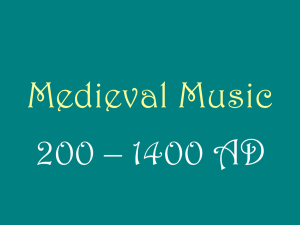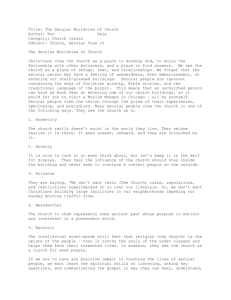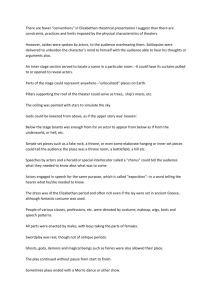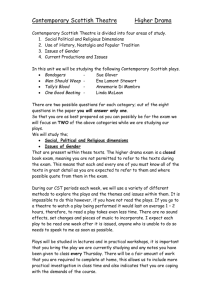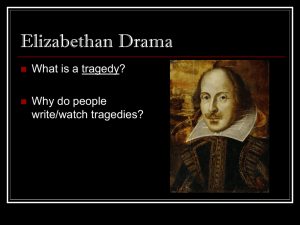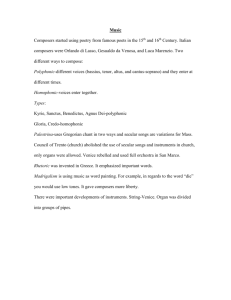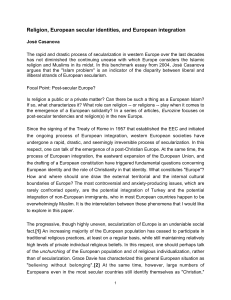Spanish Renaissance
advertisement
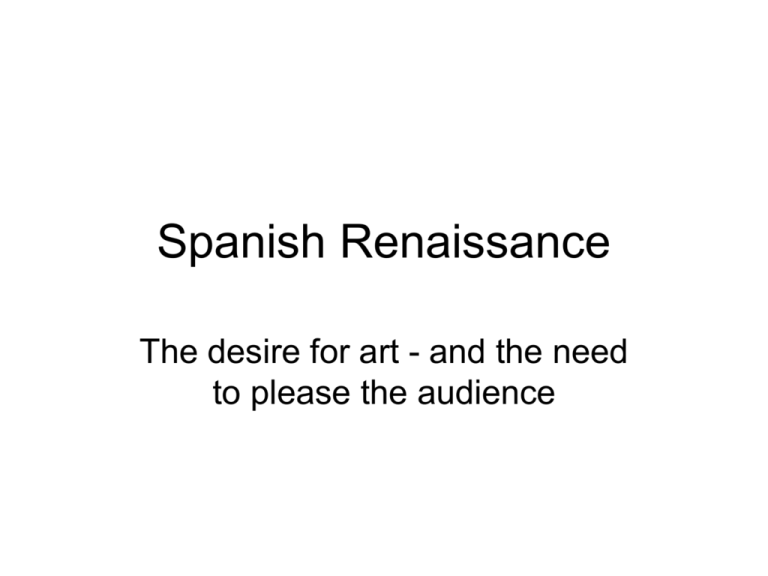
Spanish Renaissance The desire for art - and the need to please the audience Social Ideas • The Christian Project – Preservation of Spain to the “true Roman Catholic Church” – Casting out of ‘infidels” – Formation of the Inquisition: the source of standards of approved behavior encompassing social as well as religious concepts. – 1492 all Jews were ordered to convert or leave. 1502 Muslims same order. – Rise of Protestant thought in countries that had traditionally been enemies meant viewpoint as the “saviours of the true faith”. Social Ideas • Expansion and Withdrawal – 16th century brought tremendous riches from overseas exploration. – Influence and presence was dominate in European affairs. – Spain controlled: South America, Central American, Mexico, signifigant portions of North America, and most of the South Pacific. – Fearing Europe’s growing placing of secular over sacred duties, in 1599 Kin Felipe II bans Spanish students from attending foreign universities. – By 1588 the defeat of the Spanish Armada causes Felipe to turn his attentions inward. – This isolationism caused (ironically) an explosion in the arts in a separate way from the rest of Europe. Painting • El Greco (1541-1614) Captures the religious intensity of the times. Not content in the Renaissance interest in perspective and verisimilitude, he focuses on the unseen realities of the spiritual realm. Painting • Velasquez (1599-1660) Almost totally ignored religious figures/issues. Hired as a court painter. Tends to paint portraits. Literature • Cervantes (1547-1616) – Don Quixote (1605) most famous – Rode in the Last Crusade – Also a playwright - although not successful. – Mostly wrote entremeses - short comic pieces performed between acts of a play Theatre • Interested in the classical rules • Strove to strike a balance between secular and religious • 2 types – Auto sacramental - religious plays written for the Feast of Corpus Christi – Various forms of secular drama Auto Sacramentales • • • • Written specifically for Feast of CC Mounted at great expense and care Highlight of the theatre year Sources of civic pride: each municipality attempted to outdo its neighbors • Encompassed 8 days • Premier performance for king, 2-3 for state and local officials, 1-2 public performances • In terms of time, energy, and talent invested they were a significant endeavor. Secular • Fully commercial entreprise • Troupes licensed to perform for a specific length of time in each city • Performances were given all year (except during Lent) • Fall/Winter 2pm and Summer/Spring 4pm • Sunday was the popular day for theatre-going Locations (Theaters) • Autos were performed in open, unadorned platforms with a large decorated carro on either side.(Large pillars on mobile platforms). • Used for entrances/exits, musicians, special effects • Mostly standing audience. Locations (Theaters) • Secular was performed in a corrales essentially remodelings of existing inn yards with a rectangular shape. • 3 story façade w/stage at the far end of the yard. (similar to Globe) • Stage (28X25) w/curtain and trap doors (sometimes as many as 7) with stage machinery for flying effects. Performers • On the “wrong edge” of social respectability. • Enjoyed ‘professional’ status • Companies organized by actor-managers licensed by the city (autor) • As early as 1550 woman appear on stage - although only married (and not widows) • Most companies consisted of 10-20 performers (including musicians) and 3-4 actresses • Hired to play a particular type of role for the entire season • Paid well - bit actors earned as much as ‘average’ worker but many time unexpected closure of theatres. Performers • Plays of the period indicate a certain level of formality in the voice and body. • Later the presence of comedia troupes indicate the physicality of these performers was adopted into the acting style. • Several writers of the time wrote treaties that praise a naturalistic style, arguing that the audience needs to identify the actor with real life. Playwrights • More popular than individual actors, often times befriended by nobility • Capable of earning up to 20 times the average salary • Once a play was sold to an autor all rights were relinquished and the author received no other payment Technical Theatre • Scenery - emphasis on special effects rather than representation of a certain local. • Simple props in the secular with some simply painted flats in later years • Costuming was elaborate with no concern for historical accuracy but garments did indicate social status and character types. Actors were responsible for their own costumes. Some nationalities were dressed appropriately. When a script did require a woman to cross-dress she was only allowed to do so above the waist - doublet and hose thought to be indecent on a woman. Standards of Judgement • The beginning of the “critic” • De Vega’s treaty - dismisses demands for pure genre (combos of tragedy and comedy ok), urges the action of a play to be completed in as little time as possible, focus on honor, virtue, and wit, warns against the use of impossible things or inconsistent characters Lope de Vega • Considered a national hero • Wrote at least 800 dramatic works and may have written around 1800 plays • Over 450 plays still exist today • Scandal plagued his personal life • Wrote several plays w/woman as lead character Calderon de la Barca • Ranked w/de Vega • Born to low nobility • Studied at university in prep to take religious vows but a variety of person and family reasons forced him to change his mind and be took to the stage at age 23 • Authored more than 200 stage works - 200 of which still survive • Most famous play is Life is a Dream Life is a Dream • Explores several themes – Divine right of kings – Nature of reason and passion – Role of divine providence – Chance in human affairs – Concept of honor
